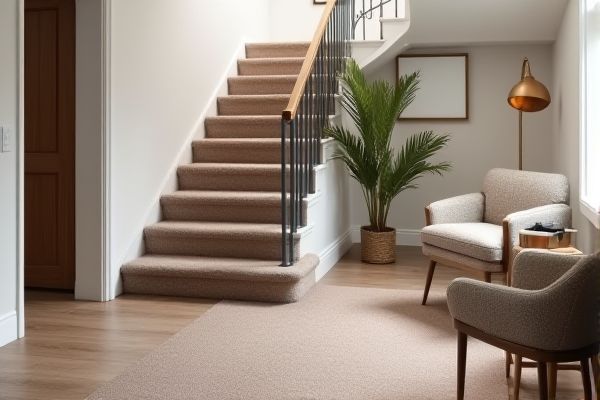
Carpet tiles offer versatile design options and easy installation for flat surfaces, while stair runners provide enhanced safety and aesthetic appeal specifically tailored for staircases. Explore the advantages and considerations of each option to determine which best suits Your home's needs.
Table of Comparison
| Feature | Carpet Tiles | Stair Runners |
|---|---|---|
| Installation | Easy to install and replace individual tiles | Requires precise measurement and professional installation |
| Durability | Highly durable, ideal for high-traffic areas | Durable but may wear faster on high-traffic stairs |
| Design Flexibility | Available in various colors, patterns, and shapes | Usually available in long, continuous strips and patterns |
| Maintenance | Easy to clean; replace damaged tiles individually | Requires regular cleaning; difficult to replace partially |
| Cost | Generally affordable, cost-effective for large areas | Usually more expensive due to custom fitting |
| Slip Resistance | Good traction depending on material | Enhanced slip resistance for stair safety |
Introduction to Carpet Tiles and Stair Runners
Carpet tiles offer versatile, modular flooring options that simplify installation and customization with various colors, patterns, and textures suitable for both residential and commercial spaces. Stair runners provide durable, decorative strips of carpet designed specifically to enhance safety and aesthetics on staircases, often made from resilient materials for high-traffic areas. Choosing between carpet tiles and stair runners depends on the area's functional needs, design preferences, and maintenance considerations.
Key Differences Between Carpet Tiles and Stair Runners
Carpet tiles offer modular installation and versatile design options ideal for large floor areas, while stair runners are specifically designed to cover stair treads and risers, enhancing safety and aesthetic appeal. Carpet tiles provide easy replacement for damaged sections, whereas stair runners require precise fitting and durable materials to withstand heavy foot traffic. The primary difference lies in application and durability, with carpet tiles suited for flat surfaces and stair runners tailored for staircases.
Design Flexibility and Customization Options
Carpet tiles offer exceptional design flexibility through modular installation, allowing for unique patterns, colors, and easy replacement of individual tiles to refresh a space. Stair runners provide a tailored, continuous strip of carpet that can be customized in width, texture, and patterns but lack the modular versatility of tiles. Both options allow for personalization, yet carpet tiles enable more dynamic and adaptable designs, making them ideal for creative or frequently updated interiors.
Installation Process: Carpet Tiles vs. Stair Runners
Carpet tiles offer a straightforward installation process with adhesive backing or tack strips, allowing for easy placement and quick customization on flat surfaces. Stair runners require precise measurement and cutting to fit each stair tread and riser, often secured with staples or nails for durability and safety. While carpet tiles allow for flexible layout changes, stair runners demand professional installation for a secure and seamless fit.
Durability and Longevity Comparison
Carpet tiles offer enhanced durability due to their modular design, allowing you to replace worn or damaged sections without redoing the entire floor, making them ideal for high-traffic areas. Stair runners, while stylish and customizable, may wear down more quickly on edges and require more frequent maintenance or replacement to maintain their appearance. Choosing carpet tiles can extend the longevity of your flooring solution by minimizing wear impact and enabling targeted repairs.
Maintenance and Cleaning Requirements
Carpet tiles offer easy maintenance with their modular design, allowing you to replace individual tiles if stained or damaged without replacing the entire floor. Stair runners, however, require more frequent deep cleaning due to high foot traffic and tight spaces that trap dirt and dust. Choosing carpet tiles can simplify upkeep and reduce long-term cleaning costs compared to traditional stair runners.
Cost Analysis: Upfront and Long-Term Expenses
Carpet tiles generally offer lower upfront costs compared to stair runners, making them a budget-friendly option for large areas or frequent replacements. Stair runners, while more expensive initially due to custom sizing and installation, often provide greater durability and longevity, potentially reducing long-term maintenance expenses. Your decision should weigh both the initial investment and the expected lifespan to optimize cost-effectiveness for your specific space.
Safety and Slip Resistance Features
Carpet tiles offer enhanced safety with customizable slip-resistant backing that reduces the risk of slips on flat surfaces, while stair runners provide continuous traction designed specifically to prevent slips on stairs. Stair runners often include added features like non-slip pads or adhesive strips to secure them firmly, minimizing movement and increasing stair safety. Both options improve grip and fall prevention, but stair runners are optimized to address the unique safety demands of staircases.
Best Use Cases for Carpet Tiles and Stair Runners
Carpet tiles excel in versatile, high-traffic areas such as offices, commercial spaces, and modular residential rooms, offering easy installation and replacement for maintaining cleanliness and design flexibility. Stair runners are ideal for enhancing safety and aesthetics on staircases, providing traction to prevent slips while adding a decorative element that complements your interior style. Your choice between carpet tiles and stair runners should prioritize the specific functional and aesthetic needs of the area being covered.
Conclusion: Choosing the Right Option for Your Stairs
Carpet tiles offer versatile, easy-to-install solutions with customizable patterns and enhanced durability, ideal for high-traffic staircases. Stair runners provide a traditional, seamless look that adds warmth and safety while highlighting the natural wood or structure beneath. Your choice depends on balancing aesthetic preferences, installation complexity, and maintenance needs to achieve the perfect finish for your stairs.
 homyna.com
homyna.com